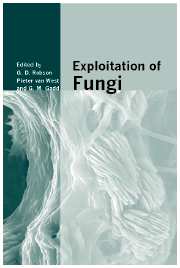Book contents
- Frontmatter
- Contents
- List of contributors
- Preface
- I Comparative and functional fungal genomics
- II Bioactive molecules
- III Protein folding and secretion
- IV Fungal bioremediation
- 10 Metal stress and the single yeast cell: Berkeley Award Lecture
- 11 Bioluminescence-based fungal biosensors
- 12 White-rot fungi and xenobiotics
- 13 Metal and mineral transformations: a mycoremediation perspective
- V Fungal biocontrol of pests
- Index
- References
11 - Bioluminescence-based fungal biosensors
from IV - Fungal bioremediation
Published online by Cambridge University Press: 05 October 2013
- Frontmatter
- Contents
- List of contributors
- Preface
- I Comparative and functional fungal genomics
- II Bioactive molecules
- III Protein folding and secretion
- IV Fungal bioremediation
- 10 Metal stress and the single yeast cell: Berkeley Award Lecture
- 11 Bioluminescence-based fungal biosensors
- 12 White-rot fungi and xenobiotics
- 13 Metal and mineral transformations: a mycoremediation perspective
- V Fungal biocontrol of pests
- Index
- References
Summary
Introduction
To apply suitable bioremediation techniques, an understanding of the physical, chemical and biological attributes of an environmental matrix is required. Effective bioremediation is based on optimizing these attributes to enhance the biodegradation of target pollutants. Fundamental to these processes is the concept of bioavailability and bioaccessibility of these pollutants at a suitable and relevant scale (Alexander, 2000; Semple et al., 2004). Environmental analyses are still based on chemical approaches that usually require an exhaustive extraction step prior to chromatographic analysis. This extracted fraction is commonly modelled to assess the portion that may cause harm to a particular target receptor. It is widely acknowledged that modelled values may be appropriate for human risk assessment (though inherently conservative) but yield little information for hazard assessment in a wider ecological or environmental context (Alexander, 2000). Many authors have demonstrated that chemical analysis alone does not provide information regarding the bioavailable fraction of compounds nor about their effects on selected biological receptors (Power et al., 1998; Hansen & Sørensen, 2001; Belkin, 2003; Paton & Killham, 2003). Biological assays are able to complement chemical analysis by considering the effects of all pollutants present in a sample, including those not detected by chemical analysis or those unable to be fitted in a model. Bioassays are used for monitoring the progress of bioremediation because they determine the bioavailable fraction of compounds that in part determines the biodegradability of a compound (Hansen & Sørensen, 2001; Paton & Killham, 2003). However, Semple et al.
- Type
- Chapter
- Information
- Exploitation of Fungi , pp. 187 - 204Publisher: Cambridge University PressPrint publication year: 2007
References
- 1
- Cited by



